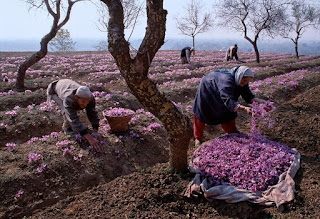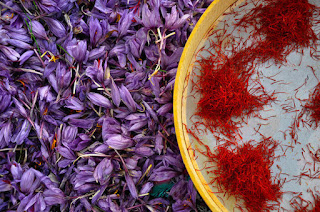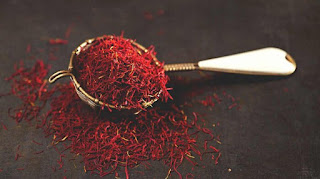Best Saffron Cultivated in Iran to export
It is well-known in the world that Iran has the best-quality Saffron that exports to thousands of distributors world-wide.
Saffron position in Iran
Saffron is one of the most valuable agricultural products in Iran.
This crop is considered to be an important export of the country despite the slight need for irrigation and protection.
Given the very favorable climatic conditions of Iran for its cultivation, as well as the growing need to know how to produce this autumn gold, this product prepares for the families of the north-east region of Iran.
Saffron cultivation and its importance in the agricultural economy
At present, it can be said that the share of more than 90% of world saffron production in Iran with regard to the area under cultivation - the two provinces of Khorasan Razavi and southern Khorasan - is the result of spending almost twice the current production cost.
If we consider the share of saffron production per hectare at an average of 5 kg (number of crops in the saffron fields during the years 1971 to 1991), we should harvest 6315 hectares of saffron in the two provinces, amounting to more than 315,000 kg of saffron.
Serious attention to quality equal to the demand of the customer in recent years has led to the desire of the buyer to be reached to the producer's ear and the quality has improved dramatically.
But we must not forget that the status quo will lead to the emergence of competitors and the gradual loss of the market.
Therefore, continuous change in production conditions to improve quality, reduce cost, increase yield and create saffron-related conversion industries is inevitable.
Finally, saffron life in a part of our country is tied to the livelihoods of hundreds of thousands of farmer families who stay in the countryside with minimal natural facilities and very little rainfall and can continue their livelihoods.
Botanicals of saffron
The saffron, scientifically named Crocus Sativus, belongs to the Iridaceae family.
It is a perennial plant with a height of approximately 30 cm that has long, green leaves such as a leek.
Its underground stem consists of two onions.
These onions are hard, circular, carnivorous and covered with thin brown color membranes.
The saffron flowers are purple, regular and consist of a long tube that leads to three petals and sepals.
Suitable climate for saffron cultivation
Saffron is a semi-tropical plant and grows well in areas with mild winters and hot summers.
Saffron resistance to cold is high but since its growth coincides with autumn, winter and early spring, naturally temperate weather is needed at this time.
Suitable land for planting saffron
Since saffron onions have a corm and are fertilized every year, the land should preferably have loamy soil, clay and sandy loam so that they can reproduce easily.
Time of planting saffron onions
The best time to plant and transplant saffron onions is in the first half of July. Saffron onions need to be removed from the old land for a maximum of two weeks and planted in the new land.
How to plant saffron onions
First, it is necessary to level the ground so that it is perfectly uniform, because in the case of rough terrain, a part of it that is tall will have less water and a part that is hollow will collect extra water.
Dehydration and waterlogging cause uniformity of production at the farm level.
The soil is then irrigated to a low level and spread to the ground at a level of 20 to 30 tonnes per hectare from rotting animal manure (preferably cow manure) and then fertilized with a tractor.
First create a furrow about 20cm deep and 25cm wide, then plant on both sides of the furrow about 7cm long on the groove, making sure the bottom of the bulb is on the ground to prevent rotation. We cut the onion in the soil a little.
After the full width of the land has been planted in this way, the same furrow of the same size as the previous groove will be re-planted 25 cm away from the previous groove and the soil removed from the groove will be laid in the previous groove. It should be planted in the same way.
Harvesting and Processing Iranian Saffron
Harvesting the saffron flower is done by hand only.
The best time to harvest the saffron is to make the saffron fragrance and color very early in the morning before the buds open.
Harvesting saffron flowers or buds requires a great deal of patience.
The action of the picking flower is like this to take the tip of the bud and pull the flower out.
Immediately after saffron separation, drying operations are usually carried out in three ways:
- The best way to dry, which is inexpensive and not time consuming, is to make 4 metal stands of 1-meter height that have 3 or 4 floors 20 cm apart. The floors are made of mesh and portable. Quickly dry the saffron by placing 4 stand next to the heater and at high heat and using the wind or ceiling fan.
- Traditional method: Put the stigma of the flower isolated on the shade on a surface to gradually dry out. In the old days and sometimes nowadays, saffron is dried in the sunlight, which is unnatural and reduces pigmentation, as well as the possibility of contamination with foreign materials, increasing dust and not economical value.
- Testing method (sieve and heater) In this method of drying, some moistened saffron is poured into a sieve-shaped container consisting of a silk mesh and about 50 cm away from heat sources which may be electric or gas. They do not contain smoke and odor, and after drying they are placed in closed containers.
How to keep and protect Iranian Saffron
Completely dried saffron should be kept away from light and moisture.
The saffron is stored in a metallic or metallic opaque container at a moderate temperature, as the saffron essential oil is volatile, if it is stored improperly it evaporates over time and reduces its medicinal and taste effects then its quality is lost.
It is recommended not to use plastic containers, especially used nylons, for saffron storage and to ensure that the saffron does not break or crack.
Iranian Saffron consumption
For Food consumption
According to the US Food and Drug Administration (FDA), saffron is authorized as a natural dye, and its use as a natural flavoring.
Medicinal uses of Saffron
Saffron is due to its active ingredients such as Crocin, Crocetin and other types of carotenoids can reduce the tumor state of the tissues and have anti-cancer properties, and can also reduce the serum lipid levels and cause a hypolymphemic state (hypoglycemic) in the blood serum.
It also increases tissue oxygenation and can significantly prevent disorders such as Alzheimer's and Parkinson's.
Industrial Use of Iranian Saffron
Saffron is used in the industry to dye silk and yarn




